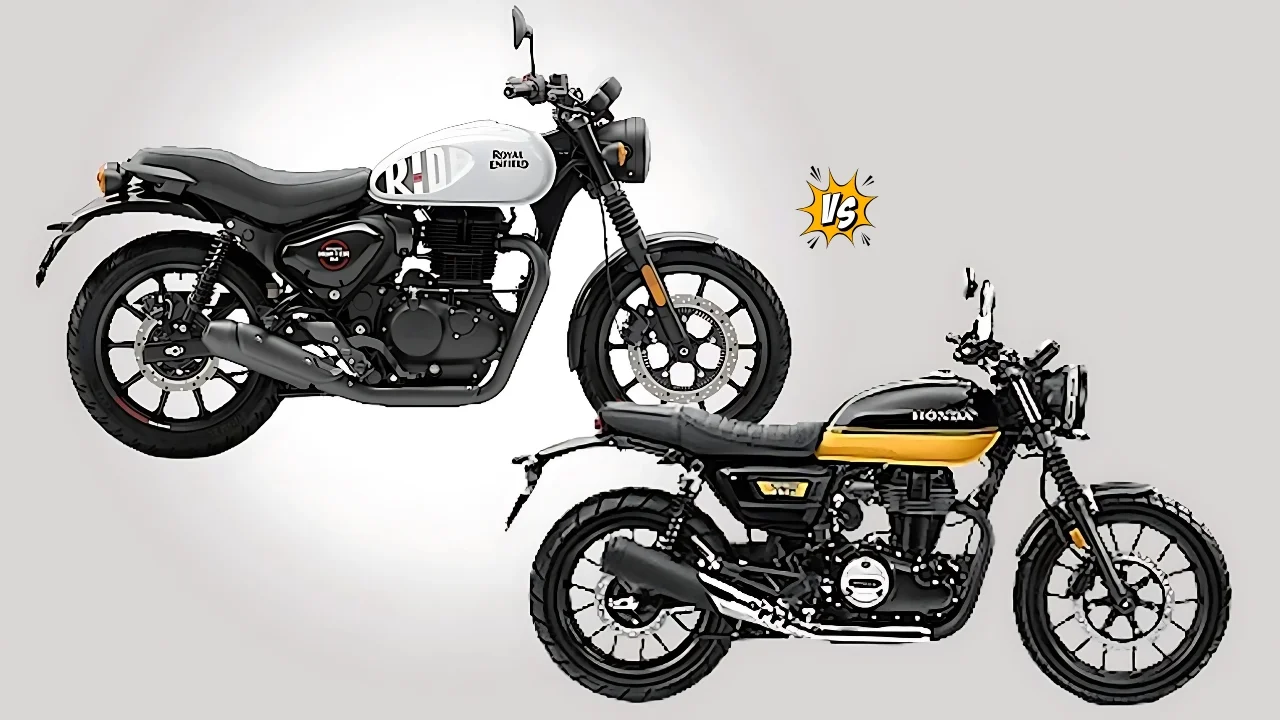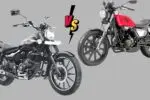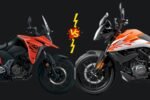Royal Enfield has rolled out a subtle yet impactful update to its most budget-friendly model in India—the Hunter 350. Known for being one of the easiest Royal Enfield bikes to ride, the 2025 iteration has been refreshed with improvements aimed at enhancing comfort, specifically addressing its previous ride quality concerns. Meanwhile, Honda’s CB 350 RS continues to be a solid contender in this segment, known for its refined engine and premium styling. With the Hunter 350 now offering better ride dynamics and new color options, its rivalry with the CB 350 RS heats up again. Here’s a detailed comparison of both motorcycles across various parameters.
Contents
Design and Features: Minimalism vs Style
The 2025 Royal Enfield Hunter 350 carries forward the same design ethos as before—compact, minimalist, and modern-retro. The design includes a circular LED headlamp, dual-channel ABS, telescopic front forks, dual rear shock absorbers, and disc brakes at both ends. The semi-digital instrument console is straightforward and easy to read. With new color schemes added, Royal Enfield aims to appeal to a younger, urban audience who prefer a stylish, nimble bike.
On the other hand, the Honda CB 350 RS leans more towards a sporty retro aesthetic. It boasts larger dimensions, giving it a more commanding road presence. It, too, is equipped with telescopic forks, twin shock absorbers, front and rear disc brakes, and a semi-digital dash. Despite its larger stance, the CB 350 RS retains a lightweight character that appeals to new riders and experienced commuters alike.
Dimensions and Ergonomics
While the Hunter 350 looks compact and low-slung, especially for a Royal Enfield, the CB 350 RS appears broader and more substantial. Despite the visual difference, the weight of both motorcycles is nearly identical:
| Specification | Hunter 350 | CB 350 RS |
|---|---|---|
| Front Suspension | Telescopic | Telescopic |
| Rear Suspension | Dual Shock | Dual Shock |
| Front Brake | 300 mm Disc | 310 mm Disc |
| Rear Brake | 270 mm Disc | 240 mm Disc |
| Front Tyre | 110/70 R17 | 100/90 R19 |
| Rear Tyre | 140/70 R17 | 150/70 R17 |
| Seat Height | 790 mm | 800 mm |
| Dashboard | Semi-digital | Semi-digital |
| Kerb Weight | 181 kg | 180 kg |
| Fuel Tank | 13 litres | 15 litres |
The Hunter 350 offers a slightly lower seat height, which is beneficial for shorter riders. Meanwhile, the CB 350 RS features a larger front wheel (19-inch vs 17-inch on the Hunter), which can translate to more stability over potholes and broken roads.
Engine and Performance
Both bikes are powered by air-cooled, 350cc single-cylinder engines paired with a 5-speed gearbox. However, Honda has managed to extract slightly more power and torque from its unit:
| Engine Spec | Hunter 350 | CB 350 RS |
|---|---|---|
| Displacement | 349 cc | 348.36 cc |
| Power | 20.2 bhp | 20.78 bhp |
| Torque | 27 Nm | 30 Nm |
| Gearbox | 5-speed | 5-speed |
While the differences may seem minimal on paper, the Honda CB 350 RS has a smoother and more refined engine, offering better performance in the mid-range. The Hunter 350, however, delivers its torque lower in the rev range, making it a better pick for city commuting and stop-go traffic.
Ride Quality and Comfort
Royal Enfield has made a notable improvement in the 2025 Hunter 350’s ride quality, addressing a long-standing concern from users of previous models. The updated suspension setup absorbs road imperfections more effectively, resulting in a more comfortable ride.
The CB 350 RS already had a reputation for offering a plush ride, and that continues with this model. The bike remains composed on bumpy roads and offers a slightly more upright and relaxed riding posture, which might be preferable for longer journeys.
Features and Tech
Both motorcycles feature semi-digital instrument clusters, LED lighting, and dual-channel ABS as standard. However, Honda edges ahead slightly with better switchgear quality and more refined fit and finish.
Key Features Comparison:
- Hunter 350: LED headlamp, USB charger (depending on variant), semi-digital console
- CB 350 RS: LED lighting all around, Honda Smartphone Voice Control System (HSVCS) in higher variants, better quality components
Price Comparison
Price plays a crucial role in this segment. The Hunter 350 is significantly more affordable, making it attractive for first-time buyers and younger enthusiasts.
| Model | Starting Price (Ex-showroom) |
|---|---|
| Royal Enfield Hunter 350 | Rs 1.49 lakh onwards |
| Honda CB 350 RS | Rs 2.15 lakh onwards |
The Hunter 350 offers excellent value for money, especially for riders who prioritize brand legacy, retro design, and daily usability. Meanwhile, the CB 350 RS demands a premium but justifies it with better refinement, more features, and superior build quality.
FAQs: Royal Enfield Hunter 350 vs Honda CB 350 RS
Q1. Which bike has better mileage, the Hunter 350 or CB 350 RS?
Both bikes offer comparable fuel efficiency. The Hunter 350 returns around 35-40 kmpl, while the CB 350 RS offers slightly better mileage in the range of 38-42 kmpl depending on riding conditions.
Q2. Which motorcycle is better for city use?
The Hunter 350, with its compact size, lower seat height, and torquey nature, is better suited for urban commutes and city riding.
Q3. Which bike offers more features?
The Honda CB 350 RS provides more advanced features, especially in its higher variants, such as Honda’s voice control system and better quality switchgear.
Q4. Which bike is more comfortable for long rides?
While both are reasonably comfortable, the CB 350 RS has a slightly more relaxed ergonomics setup and better ride stability, making it more suited for longer journeys.
Q5. Is the price difference between the two justified?
Yes, depending on what you’re looking for. The Hunter 350 offers great value for money, while the CB 350 RS brings additional refinement and features that justify its premium.
Conclusion
The 2025 Royal Enfield Hunter 350 and the Honda CB 350 RS cater to riders looking for retro charm with modern functionality. While the Hunter 350 is the more budget-friendly and agile option ideal for city riding, the CB 350 RS delivers more refinement, power, and premium appeal. Choosing between them depends on your priorities—affordability and brand legacy or refinement and advanced features.




